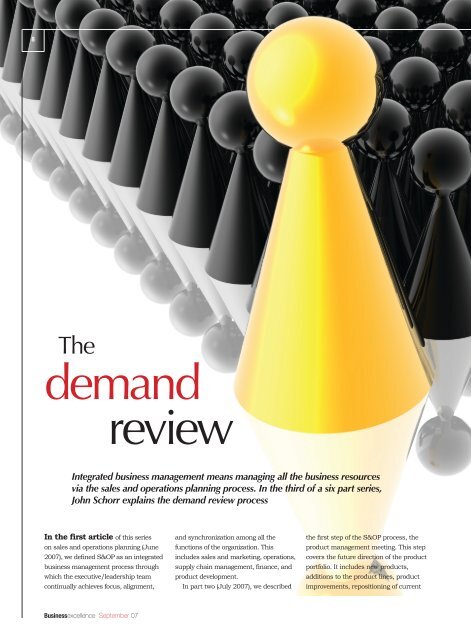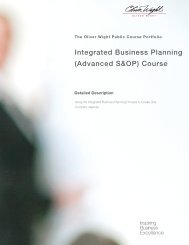The Demand Review - Oliver Wight Americas
The Demand Review - Oliver Wight Americas
The Demand Review - Oliver Wight Americas
You also want an ePaper? Increase the reach of your titles
YUMPU automatically turns print PDFs into web optimized ePapers that Google loves.
8<br />
<strong>The</strong><br />
demand<br />
review<br />
Integrated business management means managing all the business resources<br />
via the sales and operations planning process. In the third of a six part series,<br />
John Schorr explains the demand review process<br />
In the first article of this series<br />
on sales and operations planning (June<br />
2007), we defined S&OP as an integrated<br />
business management process through<br />
which the executive/leadership team<br />
continually achieves focus, alignment,<br />
and synchronization among all the<br />
functions of the organization. This<br />
includes sales and marketing, operations,<br />
supply chain management, finance, and<br />
product development.<br />
In part two (July 2007), we described<br />
the first step of the S&OP process, the<br />
product management meeting. This step<br />
covers the future direction of the product<br />
portfolio. It includes new products,<br />
additions to the product lines, product<br />
improvements, repositioning of current<br />
Businessexcellence September 07
Strategic management<br />
9<br />
products, and end-of-life rationalization<br />
of older products.<br />
<strong>The</strong> second step of the S&OP<br />
process is the demand review (Figure<br />
1), which is the focus of this article.<br />
<strong>The</strong> output of the demand review is<br />
a timely aggregate unconstrained<br />
demand plan which becomes the<br />
basis for the integrated set of planning<br />
numbers used throughout the sales<br />
and operations planning process.<br />
<strong>The</strong> key to this step is in having an<br />
excellent demand management process.<br />
<strong>Demand</strong> management is the function<br />
of recognizing all of the demand for the<br />
products and services that are required<br />
to support the marketplace. <strong>Demand</strong><br />
management encompasses the activities<br />
of demand planning, order entry, and<br />
order promising.<br />
<strong>Demand</strong> elements include customer<br />
orders, sister division requirements,<br />
samples, displays, spare parts, and<br />
internal needs, such as branch<br />
warehouse/distribution center<br />
requirements, interplant orders, and<br />
aftermarket and service requirements.<br />
Service demand includes that which is<br />
required for implementation support<br />
and maintenance or repair support.<br />
<strong>The</strong> major components of demand<br />
management include the demand plan,<br />
the assumptions behind the plan, and<br />
the action plans necessary to execute<br />
the plan. Specifically, action plans are<br />
created to assure that the anticipated<br />
demand happens. <strong>The</strong> plans also help<br />
to prioritize the demand when there<br />
is a shortage of supply. And when<br />
demand exceeds supply, the plan<br />
defines the policy that determines how<br />
the product is to be allocated among<br />
the various customers.<br />
<strong>The</strong>re are four major steps in the<br />
demand management process:<br />
1. Create the demand plan. <strong>The</strong> first<br />
thing is to predict what your customers<br />
are going to buy. A demand plan is the<br />
forecast plus the assumptions behind<br />
the forecast plus the action plans to<br />
make the demand plan happen.<br />
<strong>The</strong>re is a significant difference<br />
between a forecast and a demand<br />
plan. A forecast is typically a number<br />
generated either by a statistical forecast<br />
package or developed manually<br />
based on history. Historical data is<br />
projected into the future using a series<br />
of algorithms to identify patterns and<br />
trends. By connecting where you<br />
September 07 Businessexcellence
10<br />
Integrated Business Management – S&OP<br />
figure 1<br />
have been to where you are going, the competitive analysis, economic analysis,<br />
statistically derived forecast gives a base and external factors. <strong>The</strong> marketing view<br />
set of numbers from which to work. tends to be longer range in scope.<br />
<strong>The</strong> one thing we know about<br />
• <strong>The</strong> sales view. This includes sales<br />
forecasts, however, is that they are plans, territory plans, customer plans,<br />
constantly changing. A statistically and incentive plans. <strong>The</strong> sales view<br />
generated forecast by itself is insufficient tends to be a shorter range perspective.<br />
to generate valid demand plans. <strong>The</strong> • <strong>The</strong> product management view.<br />
forecast itself may not be incorrect, but This includes the plans to develop the<br />
the assumptions behind the numbers brand and products as well as the future<br />
are usually the cause of error. <strong>The</strong>se view of the products.<br />
assumptions are typically about the • <strong>The</strong> customer view. This includes<br />
customer, the market size, market the customers’ selling and marketing<br />
share projections, the competition, the plans, promotions, buying plans, and<br />
economy, the leading indicators, product schedules.<br />
availability, and your company’s sales • <strong>The</strong> statistical view. This includes<br />
and distribution resources.<br />
the statistical forecast and any<br />
<strong>The</strong> accuracy of these assumptions modifications to the forecast needed to<br />
needs to be measured to determine correct for abnormal demands or known<br />
which assumptions were correct and changes to the forecast over time.<br />
which were not. <strong>The</strong>se findings foster • <strong>The</strong> business plan and strategy<br />
a better understanding of what drives view. This enables us to see the gaps in<br />
demand and ultimately leads to the revenue between the demand plans and<br />
creation of an improved and valid the business plan.<br />
demand plan.<br />
When all of these inputs are collected,<br />
To develop this plan, an organization analyzed, and included in the demand<br />
requires multiple views and inputs of the plan, the demand plan is in reality the<br />
demand, among them:<br />
collective, collaborative best judgment of<br />
• <strong>The</strong> marketing view. This includes the sales and marketing functions of the<br />
market plans, pricing plans, promotions, business.<br />
2. Communicate the demand plan<br />
details. <strong>The</strong> demand plan is the basis<br />
for the integrated set of planning<br />
numbers used throughout the sales and<br />
operations planning process, therefore<br />
it is essential to share the demand<br />
plan’s details at both the aggregate and<br />
mix levels to all the functions of the<br />
business. It needs to be communicated<br />
to the sales organization that has to<br />
execute it, to the supply organization<br />
that has to make it, and the finance<br />
organization that has to cost it out and<br />
compare it to the business plan.<br />
3. Create a consensus plan. In the<br />
third step of the demand management<br />
process the objective is to influence<br />
the key players to develop a consensus<br />
demand plan. <strong>The</strong> sales organization<br />
typically talks in terms of customer or<br />
territory plans while marketing talks<br />
in terms of market or product plans.<br />
Because they see the world from<br />
different perspectives, their views of<br />
the future are often not in alignment.<br />
<strong>The</strong> demand management process,<br />
properly executed, brings these two<br />
views together where they jointly develop<br />
a demand plan that marketing can<br />
support and sales can commit to sell.<br />
4. Manage the exceptions. <strong>The</strong> fourth<br />
element focuses on the timely and<br />
effective management of exceptions,<br />
such as abnormal demand, and to<br />
control areas such as the allocation<br />
of product. When abnormal demand<br />
occurs, demand management must<br />
decide how to accommodate this<br />
demand while still protecting its<br />
regular customers.<br />
<strong>The</strong> demand review meeting in the<br />
sales and operations planning process<br />
reviews and considers inputs such<br />
as business strategy, sales forecast,<br />
customer plans, market intelligence,<br />
statistical projections, and the product<br />
management plans. <strong>The</strong> product<br />
portfolio changes developed in the first<br />
step of the S&OP process are included<br />
(Figure 2), as these inputs are the basis<br />
Businessexcellence September 07
Strategic management<br />
11<br />
<strong>Demand</strong> <strong>Review</strong> Meeting<br />
figure 2<br />
for the demand review meeting.<br />
critique the data presented, and jointly<br />
<strong>The</strong> demand review step is owned by develop the assumptions that will be<br />
the head of sales and marketing and used as the basis of the demand plan<br />
is facilitated by a demand manager, a and discuss how those assumptions will<br />
critical position responsible for pulling impact the plan.<br />
all the inputs together, critiquing the <strong>The</strong>y also review past performance<br />
data prior to the meeting, and facilitating in the areas of demand plan accuracy,<br />
the demand plan development through sales plan accuracy, demand plan<br />
the demand review process. <strong>The</strong> demand bias, market share, and other<br />
manager also has the responsibility to appropriate process metrics. <strong>The</strong><br />
monitor actual performance to plan, attendees review the changes to the<br />
manage any abnormal demands as they demand plan from the previous month<br />
arise, and update the plans based on and determine whether those changes<br />
daily discussions with sales, customer are one-time, short-term, or long-term<br />
service, and supply planning. This is a trends that need to be included in the<br />
full-time job.<br />
updated demand plan. <strong>The</strong> goal of<br />
<strong>The</strong> demand review meeting is<br />
this meeting is to develop a consensus<br />
attended by sales, marketing, product demand plan for senior management’s<br />
management, the new product<br />
review and consideration.<br />
coordinator, the supply manager,<br />
<strong>The</strong> outputs of the demand review<br />
and the demand manager. <strong>The</strong>y work meeting are the timely unconstrained<br />
together to integrate all the inputs, demand plan in both aggregate by<br />
family and detail by sub-family with<br />
the reasons for changes summarized,<br />
the assumptions documented, and<br />
vulnerabilities and opportunities to<br />
the plan noted. <strong>The</strong> unconstrained<br />
demand is the amount of demand for<br />
the product or service assuming there<br />
are no constraints. Unconstrained<br />
demand, however, is constrained only<br />
by the company’s strategies and the<br />
marketing and sales budget. Given the<br />
strategies and budgets, unconstrained<br />
demand is what sales realistically<br />
projects that it can sell.<br />
In the management business review<br />
meeting (step five of the five step sales<br />
and operations planning process),<br />
however, senior management may<br />
choose to constrain the demand and<br />
limit what sales can sell. <strong>The</strong> objective<br />
and goal of the demand review meeting<br />
is to develop a demand plan of what<br />
the company realistically expects to<br />
sell in the marketplace. It is senior<br />
management’s role to either provide<br />
the necessary capacity or constrain<br />
the demand to achieve the defined<br />
business objective.<br />
<strong>The</strong> demand review meeting of the<br />
sales and operations planning process<br />
establishes a valid demand plan that is<br />
agreed to by both sales and marketing,<br />
identifies the gaps to the business and<br />
strategic plans, develops the necessary<br />
plans and actions that will eliminate<br />
or narrow those gaps, and which will<br />
enable the company to effectively<br />
execute its business plan.<br />
<strong>The</strong> supply review meeting, from<br />
which valid supply plans are developed<br />
to execute the demand plan, will be the<br />
next topic of discussion in this series<br />
on sales and operations planning/<br />
integrated business management.<br />
John E. Schorr, a principal with <strong>Oliver</strong> <strong>Wight</strong>, is recognized as one of the leading experts in the areas of sales &<br />
operations planning (S&OP). Prior to joining <strong>Oliver</strong> <strong>Wight</strong>, John was involved in the implementation of MRP II at<br />
Haworth, where he was vice president of manufacturing, and Steelcase, one of the leading Class A users of MRP II,<br />
where he was director of purchasing.<br />
September 07 Businessexcellence
















